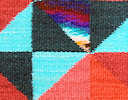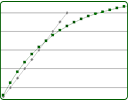IntMath Newsletter: No cost math books, math in art, Manga Guide review
By Murray Bourne, 15 Aug 2012
15 Aug 2012
In this Newsletter:
1. Resource: free math textbooks
2. Math in Art - Bridges 2012
3. Manga Guide to Linear Algebra review
4. F1gur471v31y 5p34k1ng?
5. Math puzzles
5. Friday math movie
6. Final thought - a 2-letter approach to life
1. Resource: Zero cost math textbooks
Here is a great collection of freely available math books, mostly in PDF form:
Free Textbooks in Mathematics (It appears these have disappeared)
The topics are mostly college-level, but there are some books suitable for high school. The books are about:
- General Mathematics
- Number Theory
- Algebra and Algebraic Geometry
- Topology
- Analysis
- Geometry
- Mathematical Physics
- Probability Theory
- Applied Mathematics
- History of Mathematics
- Writing Mathematics
Near the bottom of that page there are links to "Other Lists" of similar no-cost books.
2. Math in art: The Bridges Organization
 |
The Bridges Organization brings together math and art. They run a yearly conference which includes a math art exhibition. Here's an overview of the 2012 conference from Mathmunch: |
3. Manga Guide to Linear Algebra - review
 |
This Manga Guide may not be as well-executed as earlier books in the series, but it still makes a good read. |
4. F1gur471v31y 5p34k1ng?
Here's a bit of fun I received in my mail recently.
7H15 M3554G3
53RV35 7O PR0V3
H0W 0UR M1ND5 C4N
D0 4M4Z1NG 7H1NG5!
1MPR3551V3 7H1NG5!
1N 7H3 B3G1NN1NG
17 WA5 H4RD BU7
N0W, 0N 7H15 LIN3
Y0UR M1ND 1S
R34D1NG 17
4U70M471C4LLY
W17H0U7 3V3N
7H1NK1NG 4B0U7 17.
B3 PROUD! 0NLY
C3R741N CL3V3R
P30PL3 C4N
R3AD 7H15.
5. Math puzzles
In the last mail I challenged you with 2 puzzles.
(a) The first puzzle involved a question about tennis. Guido answered it correctly!
(b) The second puzzle involved a constrained data model. I posed that challenge because earlier I'd received a mail from a 78 year-old reader who proposed such a model. The following article tells the story and outlines his model.
 |
Constrained data model - solution(?) A reader recently sent me an interesting data model that he once used in his work. The model fulfills his constraints, but is not very versatile. |
(c) New puzzle: One thousand dollars is divided between Percy, Quincy and Robby as follows. Percy gets $1, Quincy gets $2, Robby gets $3, then Percy gets $4, Quincy gets $5, and so on. How much does Quincy get? Please answer here.
Please note: I will only publish solutions that show reasoning!
6. Friday math movie: The greatest (math) machine that never was
 |
Charles Babbage designed a mechanical, steam-powered "computer" in the 1830s. Here's the story. |
7. Final thought - a 2-letter approach to life
A confident person doesn't need big words to express their way of going about things:
"If it is to be, it is up to me."
Until next time, enjoy whatever you learn.
See the 10 Comments below.
15 Aug 2012 at 2:43 pm [Comment permalink]
In the mathematics orientation camp "detective game" we had to decipher a password.
It took a while before we realized it was
obtained by reversing the password and then substituting numbers for alphabets.
That is, a suspect called Wing loves Heidi, a character in the crime story. Heidi turned out to have murdered Wing, to everyone's surprise.
15 Aug 2012 at 4:16 pm [Comment permalink]
For 1000 dollars, the series of
1,2,3,4,...,n
Must add up to at max 1000. Using the formula for the sum of an arithmetic series, Sn = (n/2)[2a+(n-1)d], where:
Sn = Sum of series from 1 to n
a = Value of first term
d = Difference between two consecutive terms
We then arrive at a quadratic equation; n2 + n - 2000 = 0.
Solving the equation, we obtain a positive root value of 44.224.
Since the sum has to be equal to 1000 or less, the root value must be equal to 44.224 or less.
Since 44.224 is not an integer, we have to take a value of 44 instead (since it cannot be more than 44.224).
Since there are 44 terms and three people, there are 3x14 cycles and two remainder terms. The second of the remainder terms can be attributed to Quincy, giving her a total of 14+1=15 terms.
Quincy's sequence is as follows:
2,5,8,11,... up to the 15th term.
The amount she gets is, using the same formula:
Sn = (n/2)[2a+(n-1)d]
= 7.5 [4 + 14(3)]
= 7.5 (4 + 42)
= 7.5 (46)
= 345 dollars
Alternatively, the 15th term can be obtained by the formula:
Tn = a + (n-1)d
= 2 + 14(3)
= 44
The alternative formula for the sum is as follows:
Sn = (n/2)(a+l)
= 7.5(2+44)
= 7.5(46)
= 345
Where:
a = First term
l = Last term
Thereby still producing the same answer. =)
15 Aug 2012 at 10:09 pm [Comment permalink]
In this month's puzzle, $1,000 is being divided among Percy, Quincy, and Robby. Percy gets the first dollar, then Quincy gets the next two dollars, Robby the next three dollars, and the remaining money is divided so that the next person in sequence gets one more dollar than the previous person.
Robby therefore gets $3, $6, $9, etc. Quincy gets one dollar less than Robby in each round.
The money will be exhausted when ((3n * (3n + 1))/2 is greater than $1,000, where n is the round (the cycle where Percy, Quincy, and Robby get paid). After 15 rounds,
((3 * 15) * (3 * 15 + 1))/2 = (45 * 46)/2
= 45 * 23
= 1,035
Therefore, the money was exhausted in the 15th round. Robby would have gotten 3(15) or $45, but there was only enough money to pay him $10. Then, at the end of round 14,
(42 * 43)/2 = 21 * 43
= 903
has been paid, leaving $97.
Going back to round 14, Robby has been paid
3 + 6 + 9 + ... + 42 = 3(1 + 2 + 3 + ... + 14)
= 3(14 * 15)/2
= 3(105)
= 415
Therefore, Quincy has been paid $415 - 14 = $401.
In round 15, Percy is paid $43, Quincy is paid $44, and the remaining $10 goes to Robby.
So Quincy has been paid $445.
16 Aug 2012 at 8:22 am [Comment permalink]
Solution to the puzzle:
Construct a matrix A with three columns where row k+1 has the elements (3 k+1, 3 k+2, 3 k+3), for k = 0, 1, 2,... The successive elements of the matrix, read across rows, are the payments each of the players receive as the game progresses, i.e., 1, 2, 3, 4,... At the end of the n-th round there will be 3 n payments, so that we have to find the greatest n for which the sum 3 n (3 n +1)/2 is less than or equal to 1,000. This turns out to be 14, so that the total payment at the end of round 14 is $903. After this, Percy gets $43 and Quincy gets $44, making up for a total of 903 + 43 + 44 = $990. Robby can't get his full share, and will receive only the remaining $10. Altogether he will have the sum of the terms 3 k + 3, from k = 0 to 14, i.e., 315, plus the remaining 10, that is, $325.
16 Aug 2012 at 1:49 pm [Comment permalink]
After n disbursements, the total given to Percy(P), Quicy(Q) and Robby(R) is given by:
P = 3*(n^2 - n)/2 + n
Q = 3*(n^2 - n)/2 + 2n
R = 3*(n^2 - n)/2 + 3n
The total to all three after n disbursements is found by adding P + Q + R. This must be <= 1000.
P+Q+R = 6n + 9*(n^2 - n)/2
Equating that to 1000 and multiplying by 2 yields:
12n + 9n^2 - 9n = 2000
Rearranging
9n^2 +3n -2000 = 0
which is a simple quadratic with roots close to -14.7 and 15.1. The negative root is meaningless, and since the disbursements are in integer quantities, the solution is n=15.
Actually, since Quicy is 2nd, he gets the 15th disbursement but then the bank runs out of money and poor Robby only gets 14 disbursements and some loose change.
Quicy ends up with $345. (Percy with $330 and Robby with $315 or $325 if the bank feels sorry for him and gives him the remaining $10!)
17 Aug 2012 at 6:40 am [Comment permalink]
As Quincy will receive a mid amount for FULL rounds,
an initial approximation is $1000/3 = $333
Taking this as Sn in the Arithmetic Sequence Equation,
Sn = (n/2)[2a+(n-1)d] . . Eq1
a=2 Quincy's 1st, d=3 the common difference
Solving for n as an integer yields 15 rounds to Quincy.
The value of the nth term, Tn
= a + (n-1)d a=2, n=15, d=3
= 2+ 14x3 = 44, the value of Quincy's 15th round.
Total obtained by Quincy, Sn
=(n/2)(a + L) n=15, a=2, L=44
= (15/2)(2 + 44) = $345 = ANSWER
_______________________________________________
Reconciliation:-
Total for Percy
= (n/2)[1 +(L-1)] On the 15th round Percy gets $1 < Quincy
= (15/2)[ 1 + 43] = $330
Total for Robby . Insufficient $ for full 15 round.
= (n/2)[3 +(L-2)] . Round 14 Robby gets $2< Quincy's 15th
= (14/2)[3 + 42] = $315 for 14th round.
P+Q+R =330+345+315 =990, balance of $10. To Robby L= $325
17 Aug 2012 at 12:40 pm [Comment permalink]
Math News letter is very informative ... Mostly material links you provide
19 Aug 2012 at 11:31 pm [Comment permalink]
Hi, I like this question. As in many questions we come across in real life, this question too, has no correct answer. What you can do is come up with an argument and defend it.
As said in the question, solution should be OK with two constrains.
1. There was only 1000 dollars
2. Percy gets $1, Quincy gets $2, Robby gets $3, then Percy gets $4, Quincy gets $5, and so on.
By saying "and so on" the question leads us to another question. Must Robby get 45$ in the 15th round? can we give him 10$ remaining? or should we stop at 14th round? Must we give them all 1000$...?
anyway, let us make some models to construct the answer.
S = .5n(2a+[n-1]d)
1000 = .5n(2+[n-1]1)
n ~ 44.224
which means, as said earlier, bank will be over before 45th serving. i.e money sufficient only for 14 full rounds.
let us see amounts each person gets by 14 rounds
P = 7(2+ [13]3)
Q = 7(4+[13]3)
R = 7(6+[13]3)
P = 287
Q = 301
R = 315
Total at 14th round = 903
if serve two hands of 15th round
P = 330
Q = 345
10$ is remaining.!!! either you can give it to R or you can keep it with you. 😉
Dineth
20 Aug 2012 at 1:01 am [Comment permalink]
Quincy will get dollars 2+5+8+....41. This is an Arithmetic Progression with 14 terms. The sum of this amounts to dollars 301.
3 Oct 2012 at 12:49 am [Comment permalink]
Survey asked why we study math but left no real option to give a realistic answer.
I am a psychologists and I encourage all of my older clients to begin study of something new to keep their brains alive. Math or a language work well to keep our brains in use and therefore functioning. This is a huge overlooked market for many.
Peace and Unending Happiness
Doc Harry